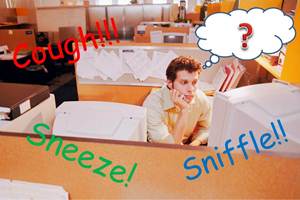statFor some women, it's about making an elegantement at special events or being a couple…

What is “Sick Building Syndrome”?
 If you find yourself inexplicably leaving work each day with flu-like symptoms that seem to disappear overnight or on weekends, you may be a victim of “sick building syndrome” (SBS). SBS is defined as a range of ailments which appear to have no specific cause but are strongly associated with a person’s place of work or their residence.
If you find yourself inexplicably leaving work each day with flu-like symptoms that seem to disappear overnight or on weekends, you may be a victim of “sick building syndrome” (SBS). SBS is defined as a range of ailments which appear to have no specific cause but are strongly associated with a person’s place of work or their residence.
Changes in building design and how buildings are ventilated since the energy crisis of the 1970s appears to be one of the main causes of sick building syndrome. Large numbers of people working closely to one another in new buildings with windows that do not open are particularly susceptible to the condition. Interestingly, however, a recent large-scale study did not find a significant association between the physical work environment and sick building syndrome. The psychosocial aspect of the work environment seemed to have a much greater effect. Those who work in high-stress jobs with little support appear to suffer from the condition the most.
The 2006 study performed by British researchers and published in the journal Occupational and Environmental Medicine analyzed questionnaires submitted by over 4,000 study participants. The survey included questions about the participants’ social and demographic characteristics, the physical work environment, psychosocial characteristics of the workplace and any SBS symptoms.
There was some indication that the greatest environmental problems were due to temperatures outside the recommended range, airborne bacteria, dust and poor relative humidity. However these were not statistically significant. The greatest association with SBS was due to psychosocial factors. The greatest number of symptoms was found in those who had little control over their work, who had an excessive work load, and who were exposed to social and mental stress at work.
Symptoms of sick building syndrome may include the following:
- Dull headaches
- Dizziness
- Nausea
- Aches and pains
- Excessive fatigue
- Vision problems
- Poor concentration
- Shortness of breath
- Coughing
- Wheezing
- Tightness in the chest
- Ear and throat irritation
- Irritated, congested or runny nose
- Skin irritation (rashes, dry itchy skin)
Symptoms may vary from day to day and can appear in different combinations. The risk of sick building syndrome is greater in buildings with open plan seating, low humidity, poor ventilation, electrostatic charges, particles from dust, carpeting or cleaning materials, a dirty working environment and poor lighting that causes visual screens to glare or flicker.
If you find yourself experiencing symptoms of sick building syndrome, discuss it with your coworkers to see if any of them may be experiencing similar symptoms. If so, consult with your employer about the possibility that working conditions may be causing your illness. Here are some steps you can take to help alleviate the problem:
· If possible, open windows to get fresh air circulating through the room
· Take regular 5- to 10-minute breaks from your computer screen, if you use one
· Arrange your furniture ergonomically to avoid unnecessary stress on your back and arms
· Organize your tasks and delegate work so as not to become stressed
· Get regular exercise to maintain good general fitness
· Follow a healthy diet and avoid sugary snacks




